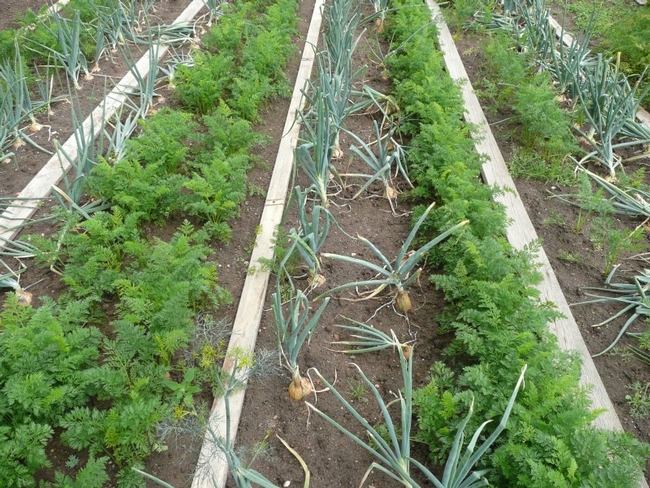By Barbara Ott, Butte County Master Gardener, April 24, 2015
Companion planting combines diverse plants in an informed manner to bring a balanced ecosystem into the garden. This approach to gardening has been used by organic gardeners for decades. The idea is to plant herbs and flowers with vegetables to create sustainable gardens with better crop yields.
Diversity is one goal of companion planting. Plants that are “companions” help each other grow—for example, tall plants provide shade for sun-sensitive plants. Companions use garden space efficiently—vining plants can cover the ground, while tall plants grow upwards through their foliage.
Using this method, companion plants are precisely placed for diversity as well as the benefits of plant health and insect disruption. One traditional plant pair is that of carrots and tomatoes, which are beneficial to one another (while, on the other hand, cabbages and tomatoes create an antagonistic combination). To maximize space in the garden, lettuce, carrots, and onions can be planted together; their roots grow to different depths so they use water efficiently.
One well-known group of companions is that of legumes, like beans, clover and alfalfa. Bacteria invade the root hairs of legumes and make nodules where these beneficial Rhizobium nitrogen-fixing bacteria live. The nitrogen these bacteria fix becomes available to the legume plant and the soil around its roots. Legumes can be worked into the soil, renewing and replacing nitrogen. This reduces the amount of manure and chemical fertilizers needed for heavy-feeding plants.
Companions can help prevent pest problems by repelling pests or attracting the beneficial insects needed to keep down the population of insect pests. Onions are one plant that repels some pests. Marigolds contain thiophene, which deters root nematodes. Chives planted alongside roses repel aphids. Nasturtiums act as a decoy crop for kale and tomatoes by attracting aphids away from the more desirable edibles (once the nasturtium plant has attracted aphids, it is removed from the garden before the aphid young develop wings). Aromatic herbs like basil, rosemary, lavender, and sage, will repel many pests. Mix these in with pest-susceptible plants. The presence of diverse plant species disrupts the ability of herbivorous insects to discover host plants for feeding or egg-laying. The time wasted on non-host plants reduces the reproductive efficiency of specialist insects.
Companions of flowers and herbs attract beneficial insects. Beneficials are predators or parasites of harmful insects. Beneficials include ground beetles,ladybugs, praying mantids, and pirate bugs. Some species of wasps, spiders, and flies are also beneficial. Plants that flower in umbels (flat-topped clusters of small flowers) such as dill, parsley, carrot, angelica and parsnip, provide habitat for beneficial insects. For example, Queen Anne's lace is an excellent habitat for small predator wasps that lay their eggs in the bodies of aphids.
Lists of specific companion plant combinations can be found on web sites and in gardening books. Find the best friends for your garden plants, to create sustainable gardens with better yields. Remember to experiment, observe and record how these companions work in your own garden.
